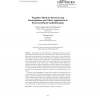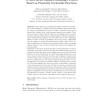17 search results - page 3 / 4 » Securing group key exchange against strong corruptions and k... |
JOC
2007
13 years 5 months ago
2007
In the security chain the weakest link is definitely the human one: human beings cannot remember long secrets and often resort to rather insecure solutions to keep track of their ...
NDSS
1998
IEEE
13 years 9 months ago
1998
IEEE
This paper presents a new password authentication and key-exchange protocol suitable for authenticating users and exchanging keys over an untrusted network. The new protocol resis...
AFRICACRYPT
2009
Springer
13 years 9 months ago
2009
Springer
The notion of certified encryption had recently been suggested as a suitable setting for analyzing the security of encryption against adversaries that tamper with the key-registrat...
Publication
To improve the already tarnished reputation of WLAN security, the new IEEE 802.11i security standard provides means for an enhanced user authentication and strong data confidential...
IACR
2011
12 years 5 months ago
2011
Abstract. Radio Frequency Identification (RFID) systems are vulnerable to relay attacks (i.e., mafia, terrorist and distance frauds) when they are used for authentication purpose...


